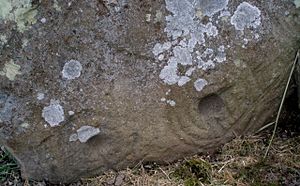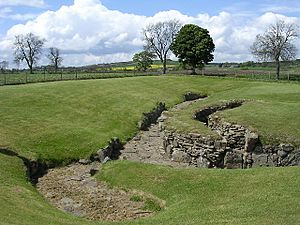Carlungie and Ardestie earthhouses facts for kids
Carlungie and Ardestie Earthhouses are amazing ancient buildings found in the farmlands near Monifieth and Carnoustie in Scotland. These special places were built a very long time ago, during the late Iron Age, around 100 to 200 AD. They are a type of underground structure called a souterrain. People likely used them to store food, keeping it cool and safe.
What are Earthhouses?
Earthhouses, or souterrains, are underground passages or chambers. They were often built by digging a trench, lining it with stones or wood, and then covering it with a roof of stone slabs and earth. This made them hidden and protected from the weather.
Why were Earthhouses built?
Archaeologists believe earthhouses were mostly used for storage. Imagine trying to keep food fresh before refrigerators! These cool, dark underground spaces were perfect for storing grains, vegetables, and other supplies. Some might have also been used as safe places to hide, or even for special ceremonies.
Ardestie Earthhouse
The Ardestie earthhouse was discovered in the 1940s near a farm called Mains of Ardestie. Archaeologists carefully dug it up, or excavated it, between 1949 and 1950. A famous archaeologist named F.T. Wainwright led this work.
Wainwright first thought that Ardestie might have been an underground shelter for cows, known as a cow byre. However, other experts have suggested different ideas. Many believe it was used for storing grain, like a giant underground pantry. Some even think it might have been used for special ceremonies or rituals.
One really cool thing about Ardestie earthhouse is that it contains very old stones. These stones were reused from even earlier times, from the Neolithic or Bronze Age. They have mysterious carvings on them called cup and ring marks. These are ancient symbols, like circles and hollows, carved into the rock. Finding them here shows how people in the Iron Age reused materials from even older settlements.
Carlungie Earthhouse
The Carlungie earthhouse was also excavated by F.T. Wainwright. He worked on it right after Ardestie, from 1950 to 1951. Carlungie is very similar to Ardestie. It was built around the same time, in the 1st or 2nd centuries AD.
Just like Ardestie, archaeologists believe Carlungie was probably used for storing food. Its design and location suggest it served a similar purpose. These two earthhouses give us a great look into how people lived and stored their food over 1,800 years ago!




